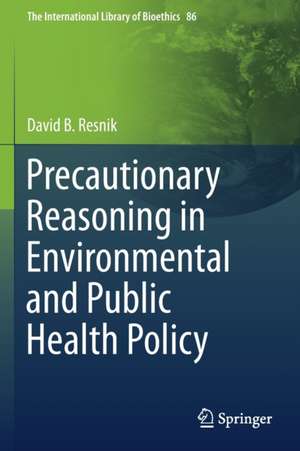Precautionary Reasoning in Environmental and Public Health Policy: The International Library of Bioethics, cartea 86
Autor David B. Resniken Limba Engleză Paperback – 29 mar 2022
| Toate formatele și edițiile | Preț | Express |
|---|---|---|
| Paperback (1) | 643.34 lei 43-57 zile | |
| Springer International Publishing – 29 mar 2022 | 643.34 lei 43-57 zile | |
| Hardback (1) | 648.24 lei 22-36 zile | |
| Springer International Publishing – 28 mar 2021 | 648.24 lei 22-36 zile |
Din seria The International Library of Bioethics
- 20%
 Preț: 695.17 lei
Preț: 695.17 lei - 20%
 Preț: 690.13 lei
Preț: 690.13 lei -
 Preț: 362.38 lei
Preț: 362.38 lei - 20%
 Preț: 692.50 lei
Preț: 692.50 lei - 5%
 Preț: 677.93 lei
Preț: 677.93 lei - 15%
 Preț: 582.63 lei
Preț: 582.63 lei -
 Preț: 385.84 lei
Preț: 385.84 lei -
 Preț: 378.92 lei
Preț: 378.92 lei - 15%
 Preț: 690.11 lei
Preț: 690.11 lei - 18%
 Preț: 790.28 lei
Preț: 790.28 lei - 18%
 Preț: 791.88 lei
Preț: 791.88 lei - 15%
 Preț: 694.69 lei
Preț: 694.69 lei -
 Preț: 447.62 lei
Preț: 447.62 lei - 18%
 Preț: 723.56 lei
Preț: 723.56 lei - 15%
 Preț: 684.85 lei
Preț: 684.85 lei -
 Preț: 382.95 lei
Preț: 382.95 lei - 18%
 Preț: 778.94 lei
Preț: 778.94 lei -
 Preț: 389.88 lei
Preț: 389.88 lei -
 Preț: 381.00 lei
Preț: 381.00 lei - 15%
 Preț: 694.69 lei
Preț: 694.69 lei - 18%
 Preț: 894.97 lei
Preț: 894.97 lei - 18%
 Preț: 721.19 lei
Preț: 721.19 lei - 18%
 Preț: 725.13 lei
Preț: 725.13 lei - 15%
 Preț: 691.59 lei
Preț: 691.59 lei -
 Preț: 382.57 lei
Preț: 382.57 lei
Preț: 643.34 lei
Preț vechi: 756.86 lei
-15% Nou
Puncte Express: 965
Preț estimativ în valută:
123.14€ • 133.80$ • 103.51£
123.14€ • 133.80$ • 103.51£
Carte tipărită la comandă
Livrare economică 21 aprilie-05 mai
Preluare comenzi: 021 569.72.76
Specificații
ISBN-13: 9783030707934
ISBN-10: 3030707938
Ilustrații: XVIII, 335 p. 21 illus.
Dimensiuni: 155 x 235 mm
Greutate: 0.5 kg
Ediția:2021
Editura: Springer International Publishing
Colecția Springer
Seria The International Library of Bioethics
Locul publicării:Cham, Switzerland
ISBN-10: 3030707938
Ilustrații: XVIII, 335 p. 21 illus.
Dimensiuni: 155 x 235 mm
Greutate: 0.5 kg
Ediția:2021
Editura: Springer International Publishing
Colecția Springer
Seria The International Library of Bioethics
Locul publicării:Cham, Switzerland
Cuprins
Chapter 1. Precautionary Reasoning.- Chapter 2. Decision Theory.- Chapter 3. Moral Theory.- Chapter 4. The Precautionary Principle.- Chapter 5. Precautionary Reasoning and the Precautionary Principle.- Chapter 6. Chemical Regulation.- Chapter 7. Genetic Engineering.- Chapter 8. Dual Use Research in the Biomedical Sciences.- Chapter 9. Public Health Emergencies.- Chapter 10. Conclusion.
Notă biografică
Dr. Resnik has been a Bioethicist at the National Institute of Environmental Health Sciences, National Institutes of Health since 2004. Dr. Resnik was an Associate and Full Professor of Medical Humanities at the Brody School of Medicine at East Carolina University (ECU) from 1998-2004, and an Associate Director of the Bioethics Center at ECU and University Health Systems from 1998-2004. Dr. Resnik was Assistant and Associate Professor of Philosophy at the University of Wyoming (UW) from 1990-1998, and Director of the Center for the Advancement of Ethics at UW from 1995-1998. Dr. Resnik has an M.A. and Ph.D. in philosophy from the University of North Carolina at Chapel Hill and J.D. from Concord University School of Law. He received his B.A. in philosophy from Davidson College. Dr. Resnik has published over 300 articles and 9 books on various topics in philosophy and bioethics and is a Fellow of the American Association for the Advancement of Science. He serves onseveral editorial boards and is an Associate Editor of the journal Accountability in Research. Dr. Resnik is also a Certified IRB Professional.
Textul de pe ultima copertă
This book fills a gap in the literature on the Precautionary Principle by placing the principle within the wider context of precautionary reasoning and uses philosophical arguments and case studies to demonstrate when it does—and does not—apply. The book invites the reader to take a step back from the controversy surrounding the Precautionary Principle and consider the overarching rationales for responding to threats to the environment or public health. It provides practical guidance and probing insight for the intended audience, including scholars, students, journalists, and policymakers.
Caracteristici
Develops a novel and useful approach to precautionary reasoning in environmental and public health policy Places the Precautionary Principle within the wider context of precautionary reasoning Uses philosophical arguments and case studies to demonstrate when the principle does—and does not—apply
